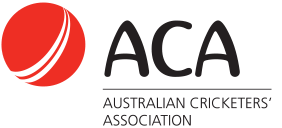Beyond the Boundary - Jason Behrendorff
15 May, 2012
Current Western Australian fast bowler and 'Future Legend' award recipient Jason Behrendorff is completing a work placement with Hockey Australia, as a part of the ACA's 'Beyond the Boundary' program.
The program focuses on providing cricketers with work experience opportunities in a range of different environments outside the sport.
The 'Future Legend' award won by Behrendorff, was announced at the WACA's Premier Cricket Awards, and is for the "Rising Star" of Western Australian cricket under the age of 23. The left-arm paceman made his first-class debut against Victoria in November, where he took 4-76. In just four matches he snared 13 wickets at 31.07. He also played five Ryobi Cup matches, with 3/45 being his best return against Queensland.
The 22-year-old took some time out his European travels to speak to us about his placement and his year with WA.
Tell us about your placement with Hockey Australia. How did the Beyond the Boundary program assist you?
The Beyond the Boundary program has a vast range of contacts and they were able to contact Hockey Australia to get me some work alongside some of their HR and sport science staff. I have only completed some of my placement due to time constraints, but so far it has been a rewarding experience. I look forward to doing more of my placement and also watching the Olympics, where the Kookaburras and the Hockeyroos will hopefully take home the gold.
What areas have you been you involved in?
I spent a lot of my time within the sport science department; working in the gym with the strength and conditioning coaches on the athletes' weights programs and out on the track doing fitness testing with the exercise physiologists.
I was also involved in the HR department working on an in-house event, where the significant others of the players (parents and/or partners) came from all across the country. They saw the environment (in which) the athletes spend the majority of their time, in preparation for the upcoming Olympics, and how they go about their daily schedules and training.
How are you finding the experience?
The experience has been really good, so far, especially being able to see how another elite sporting organisation operates. Hopefully I will be able to gain more experience in the future, as juggling both my own career and work placement meant that I couldn't work with Hockey Australia as often as I would have liked.
What has been the highlight?
The highlight would have to have been working with the Kookaburras. Being able to work with a team which is ranked number one in the world - as well as a team preparing for an Olympic games - is pretty special to be a part of.
Has sports science always been an interest of yours?
Ever since high school, I always enjoyed participating in human movement and various sports. Therefore it was a natural choice for me to study Sports Science at (Edith Cowan) university.
Did you play hockey as a youngster?
No, I have never played before. Cricket and AFL were my chosen sports when I was growing up.
What impressed you about the hockey players?
The players all have very good stick skills, allowing them to maneuver the ball easily and effectively. Speed is also a huge component of hockey and being able to sprint repeatedly with short rest periods is crucial, so, as a consequence, their level of fitness seems to be slightly higher to that of the general cricket player. These two factors allow the hockey players, especially the Kookaburras, to have high agility and seem to effortlessly manipulate the ball and themselves around their opponents.
Who were the standout players? Why?
Jamie Dwyer, to me, was great to watch. He was named the best player in the world and I think he has won that award two or three times. His control with the ball and his stick skills are second-to-none.
Watching the work the goalkeepers do is also phenomenal. They always make such precise movements and their reaction times are unbelievable.
Playing both hockey and cricket takes courage - what's tougher?
Of course, I have to say being a cricketer is tougher, especially from what I have experienced this season as a fast bowler! Having to back up four straight days of intense cricket is very tough, both physically and mentally.
Kookaburras coach Ric Charlesworth comes from a strong cricket background - do you see any similarities between the way in Australian cricket and hockey are run?
Both structures seem to be similar in regards to the strength and conditioning side and most testing protocols are very similar, if not the same.
Both hockey and cricket are sports where hand eye co-ordination for striking is critical, so it wasn't surprising to see that both hockey and cricket implement similar training cycles, such that of their training phases and core resistance exercises.
How are preparations looking for the Olympic Games in London this year?
The Kookaburras are looking very good. They won the Champions Trophy late last year and will be a force to be reckoned with at the London Olympics.
What would be your ideal job once you wrap up your cricket career?
Working with an elite sports team in their Sports Science department would be ideal, especially within the strength and conditioning side.
You made your first-class debut this season. How are you finding it at this level?
First-class cricket is by far the toughest level of cricket I have played and I wouldn't want it any other way. I really enjoyed the challenge this year and with more and more games under my belt I'm hoping to continue to grow in confidence and feel more comfortable at first-class level.
You took 13 wickets in four matches at an average of 31.07. How would you sum up your season?
I think I have made a good start. I had both high and low patches throughout those four games and if I can learn from this season and transfer that knowledge into next season, I am confident I can improve further.
What are the differences between first-class cricket and, say, Futures League or Grade cricket?
The intensity level is a lot higher in first-class cricket - more than I anticipated. By the end of the first day of my first Shield game - I don't think I have ever been so sore in my life! Although it was regarded as a pretty standard day for a bowler (bowling around 20 overs) that increase of the intensity level really took its toll on my body.
What are your goals for the 2012-2013 season?
To play more first-class cricket for WA and really use last season as a stepping stone to go onto bigger and better things. It would be a dream come true to see WA up their standings from 2011-2012 and take home a Shield title!
You're originally from Camden in NSW and played cricket in the ACT for the U19 side and Tuggeranong Valley. Was it a difficult experience making the move west?
It was quite tough for the initial period. Moving out of home for the first time as well as moving to the other side of the country isn't easy. In saying that, it has been a very rewarding experience. Playing first-class cricket was something that I always wanted to do, so I'm really glad I was given the opportunity.
How did you find combining your placement with cricket?
It has been quite tough juggling both commitments, especially as I was involved a lot more with the Warriors towards the end of the 2011-2012 season, but I'm looking forward to doing more with my placement when I am back in Australia, hopefully during the preseason.

